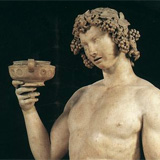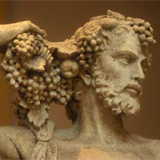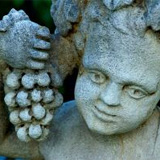Dionysus was the Greek god of wine and a major figure of Greek mythology. He represents not only the intoxicating power of wine, but also its social and beneficial influences. The geographical origins were unknown, but almost all myths depicted him as being foreign. In Greek mythology Dionysus was the son of Zeus and Semele; as Dionysus grew up he discovered the culture of the vine and the method of extracting its precious juice.
The way of the Romans was to adopt various elements from other cultures and civilisations - and this included the giving of Greek God names the equivalent Roman names. The Roman priests then adopted the mythology about the Gods and Goddesses like Bacchus. Greek and Roman religion and mythology therefore become closely entwined.
For the Romans, Dionysus became Bacchus, the son of Jupiter and Semele. A reflection on Greco and Roman philosophies regarding democratic government, Bacchus was a promoter of civilization, a lawgiver and peacemaker. Wine, it seems, began to come into its own.
The Roman Empire, though infinitely fallible, was not one to deprive its citizens of their favourite God. From 300 B.C. to the beginning of the Christian era, the population in Rome exploded from 100,000 people to over one million. The result was an equally sizeable increase in the demand for affordable wine, Rome drank 1.8 million hectolitres of wine per year. That was enough for every man, woman and child to have half a litre per day, every day of the year.
From the great vineyards of Italy to Bordeaux, Burgundy and Alsace, Bacchus single-handedly planted the first vines in what would become the world's most legendary wine regions. The Roman god of wine and intoxication, his festival was celebrated on 16 - 17 March.
The bull, the serpent, the ivy and wine are the signs of Bacchus, and strongly associated with satyrs, centaurs, and sileni. He is often shown riding a leopard, wearing a leopard skin, or in a chariot drawn by panthers, and may also be recognized by the thyrsus he carries.











